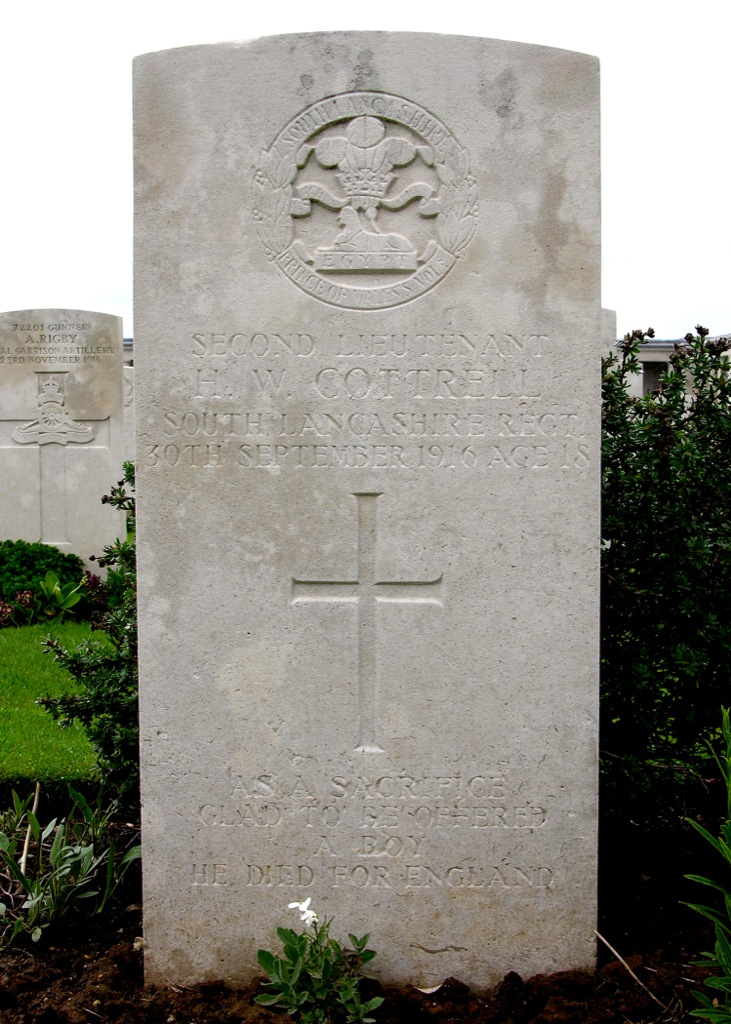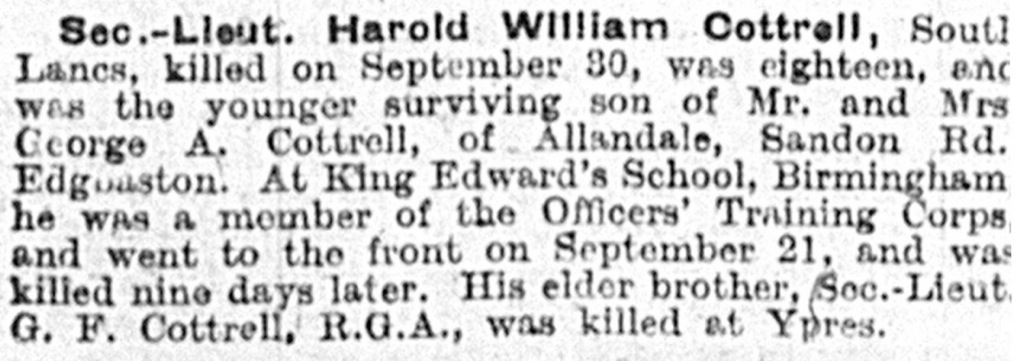Harold William Cottrell, born on 4th August 1898, was admitted to King Edward’s School in January 1910 having attended the Edgbaston Preparatory School for two years. Harold lived with his parents, George and Agnes, at 49, Sandon Road, Edgbaston. His older brother, George Frederick, also an Old Edwardian, was attached to the Indian Army and was killed at Ypres on 11th May 1915.
At School, Harold lived under the rather large shadow of his brother, George, but managed to excel at sciences and to reach the rank of Sergeant in the School Officer Training Corps. While Harold was still at School, his brother’s death at Ypres was reported in the School magazine. Harold, it seems, was keen to get to the front line to avenge the death of his only brother.
Harold applied for a temporary commission in October 1915, two months after his seventeenth birthday. In September 1916 he was given the order to proceed abroad. Taking his dead brother’s revolver, he left with one hundred men of other ranks and three other officers to join the 2nd South Lancashire Regiment on the Somme.
Harold’s abrupt departure surprised his parents who understood that boys under nineteen would not be sent abroad. However, Harold was only too keen to get involved. In his last letter to his mother on 30th September 1916, scribbled just before he went into action, Harold wrote: “We are going to take a certain bit of Hun trench…We have got the Canadians attacking on our right, and as they bear no love for Fritz, we shall be in good company…I can tell you this time there will be no prisoners, certainly not on my part because I have Freddy [his nickname for his brother, George] to think of.”
Harold was killed later that day in an almost identical situation to his brother, George, “while looking after his men under heavy shellfire.”
Six months after Harold’s death, his mother sent several letters to the War Office demanding answers as to how and why her son had been sent to the front , given his age. She wanted details including, “exactly the time of death in action and ditto burial – extent and nature of wounds and manner of identification.” The War Office reluctantly forwarded her letters to Harold’s Commanding Officer in France, apologising for wasting his time, explaining that: “Mrs Cottrell has lost her two sons in the war and it is evidently a case of a distraught mother who cannot control herself.”
The brusque response from Harold’s CO brought Agnes Cottrell little solace. On the contrary, the “curt and callous reply” added to her pain and despair. In 1922 Agnes sent a final letter, described as irrational and rambling, to the War Office. A memo in the file concluded that Mrs Cottrell was now “distinctly eccentric and unbalanced.” Agnes’ correspondence stands as a testament to the depth of her grief, so devastated was she by the loss of both sons.
Harold is buried in Pozières Military Cemetery, and is also commemorated on St Augustine’s Church War Memorial, Edgbaston. George and Agnes Cottrell paid for a separate memorial for their sons in St Augustine’s, with the inscription “They were lovely and pleasant in their lives, and in death they were not divided”. The inscription on Harold’s gravestone reads: “As a sacrifice glad to be offered. A boy, he died for England.”


.JPG)


